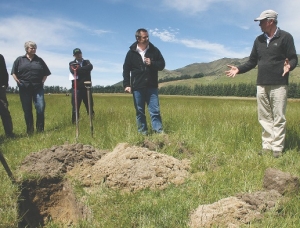That’s the underlying principle behind completing a Land and Environment Plan for a farm, says AgResearch’s Alec MacKay, one of the scientists instrumental in the revamp of Beef + Lamb New Zealand’s Land and Environment Planning Toolkit.
Soil types are a key factor, but the plan must look at the whole picture, he stresses.
“It’s not just the soil we’re thinking about, but where it sits in the landscape. For instance here, if we take those trees out, it would seriously degrade this unit of the farm,” he told field day delegates standing in a paddock on Colin and Hilary Guild’s Quartz Hill Station, Canterbury, just before Christmas.
But for a well-established pine shelter belt some 200m to the west of where the group had stopped, Mackay’s wise words would have been lost on the nor’wester ripping down the Rakaia valley.
The station’s exposure to such winds was recognised by the Guild’s when their family took it on in 1973. They’ve been steadily planting trees ever since.
“You can’t farm this land without shelter,” Colin Guild told the field day. “We always have to keep this in mind.”
An example is their approach to crop or grass establishment.
“We try not to cultivate at all, preferring to direct drill. But we will cultivate if we have to because soil’s been pugged or damaged.”
Running from 500m to just under 1000m, the altitude makes for a short growing season and a clay pan in the glacial soils limits the areas which can be grazed in winter. Again, it’s an environmental factor the Guild’s have built into their management, acquiring two run-offs to limit the number of stock they have wintering on the station.
“We keep the cattle off the heavy flats in winter… It can get impossibly wet, and did [last] year.”
Location of waterways and erosion risk is taken into account with any development, especially fencing. Tussock is preserved and encouraged near water to protect soil and water. On steeper country spraying of matagouri is “strategic” to leave some for soil and stock shelter.
Two areas of red tussock are protected by QE2 covenants.
Extensive soil testing drives nutrient management decisions.
“We have a rigid liming policy because of the wetness. We come back in [with lime] every five years.”
MacKay says when doing a LEP, the principle is to think about how best to use and preserve the resources of the farm going forward.
“You need to build on a property’s advantages without degrading its resources.”
The BLNZ toolkit splits the process into three levels: Level 1, or entry level; Level 2; and Level 3 which aims to achieve standards suitable for quality assurance programmes.
Completing a level 3 LEP will be least challenging when part of the standards are already being achieved, and a level 2 LEP has already been prepared, says the levy-body.
A manual for each level presents a step by step approach to assessing the farm’s resources
and building an appropriate management plan around them.
Northern South Island extension manager Ian Knowles says because every farm is different, there’s no one-size-fits-all solution, and every farm will need to work out their own plan.
“If this stuff was easy we’d have posted out a little capsule, but there’s no silver bullet to these things.”
Copies of the toolkit are available from BLNZ: 0800 233352. Or see www.beeflambnz.com

















